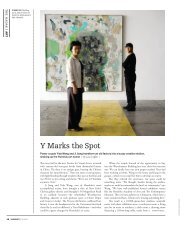The Scholarship of Teaching and Learning: TheoryâPractice - NAIRTL
The Scholarship of Teaching and Learning: TheoryâPractice - NAIRTL
The Scholarship of Teaching and Learning: TheoryâPractice - NAIRTL
You also want an ePaper? Increase the reach of your titles
YUMPU automatically turns print PDFs into web optimized ePapers that Google loves.
6 INNOVATIVE HIGHER EDUCATION<br />
did faculty members apply their learning to classroom practices? To<br />
what extent did the program meet, surpass, or fall short <strong>of</strong> expectations,<br />
why <strong>and</strong> how? What needs to be improved about this program?<br />
Follow-Up Evaluations. <strong>The</strong>se focus on issues <strong>of</strong> importance, which<br />
arose as a result <strong>of</strong> the long-term (e.g., months, year) impact <strong>of</strong> a<br />
program. For example, as a faculty member reflects upon the program,<br />
what does he/she remembers <strong>and</strong> values most? Generally speaking,<br />
to whom <strong>and</strong> to what extent, if at all, did the program make any<br />
difference? If at all, how did the program contribute to the individual’s<br />
development as a university teacher? If at all, can specific examples be<br />
provided about applications <strong>of</strong> learning to other academic activities?<br />
What were alternative or nonintended outcomes from this program?<br />
Action Research Methodology<br />
Action research methodology is central to this framework. Action<br />
research internalizes theory <strong>and</strong> practice through a systematic <strong>and</strong><br />
cyclical process <strong>of</strong> inquiry that involves hypothesis testing, planning,<br />
observing, analysis, <strong>and</strong> action (Mills, 2000; Peterat & Smith, 2001;<br />
S<strong>and</strong>er & Halas, 2003; Winter, 1996). Essentially, action research<br />
invites educational developers to consider which research questions<br />
around program development <strong>and</strong> evaluation are important, what data<br />
to gather, when <strong>and</strong> how to collect <strong>and</strong> analyze these data, how to<br />
initiate positive changes to practice, how to engage faculty participants<br />
in the process, <strong>and</strong>, finally, to consider how this research might be <strong>of</strong><br />
interest to the broader scholarly community. Data collection strategies<br />
may be in the form <strong>of</strong> quantitative (e.g., numeric performance <strong>and</strong><br />
attendance records, rating <strong>and</strong> rank-order preference scales), <strong>and</strong>/or<br />
qualitative sources (e.g., internet or documentation searches, openended<br />
feedback forms <strong>and</strong>/or interviews, interpretation <strong>of</strong> teaching<br />
performances from video footage, teaching plans, students’ assignments,<br />
workbook journals, etc.). Qualitative sources, for example, can<br />
be analyzed by categorizing data using established criteria, major<br />
themes, common or isolated experiences (Altrichter, Psch, & Somekh,<br />
1993; Bogdan & Biklen, 1992; Lincoln & Guba, 1985; Strauss & Corbin,<br />
1998). Quantitative data sources, on the other h<strong>and</strong>, lend themselves to<br />
be categorized by descriptive statistics in order to determine frequency<br />
counts, means <strong>and</strong> st<strong>and</strong>ard deviations or, if appropriate, by using<br />
more complex forms <strong>of</strong> analytical statistics. Appropriate combinations<br />
<strong>of</strong> qualitative <strong>and</strong> quantitative data can yield critical information to<br />
enhance program development <strong>and</strong> evaluation (Bullough & Pinnegar,<br />
2001).











